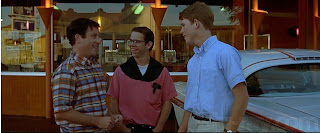By Michael Lyons
All of the nostalgia, the “retro,” the “throwbacks,” the “looking back,” the “fondly remembering” that goes on today can actually be traced back 45 summers ago, when “American Graffiti” debuted.
George Lucas’ love letter to a simpler time: the late ‘50’s and early ‘60’s, during the era of drag racing, cruising, ducktailed “hoods,” malt shops and the early years of rock and roll, connected with the generation who (in the ‘70’s) had come of age during that time.
“American Graffiti” had an almost immediate response from audiences when it was released and helped launch the career of one of Hollywood’s most influential directors.
With the film that asked the poetic question “Where Were You in ‘62?” Celebrating its 45th anniversary, it’s the perfect time to take trip back in time to revisit the film.
With a very simple plot that involves weaving a number of stories together, “American Graffiti” takes place on the last night of summer vacation and follows several friends through a number of misadventures.
There’s Curt (Richard Dreyfuss), a straight laced high school graduate, about to head off to college, who becomes obsessed with finding a beautiful blonde girl (Suzanne Somers) he spotted in a car and winds up getting mixed up with a group of “greasers;” High school sweethearts Steve and Laurie (Ron Howard and Cindy Williams) who argue and make-up throughout the evening; John (Paul LeMat) an avid drag racer who winds up squaring off in a race with a loud mouth named Bob (Harrison Ford) and Terry “Toad” (Charles Martin Smith) the “nerd’ who is thrilled to have date with Debbie (Candy Clark).
The Cast of “American Graffiti” now plays like a “Who’s Who” directory of Hollywood, but at the time, the Cast (with the exception of Howard) were relative unknowns and this turned out to be their big break. This was also a big break for director Lucas. After the success of this film (produced by his friend Francis Ford Coppola), Lucas gained some clout, which allowed him to begin work on his true passion project about a “Galaxy Far, Far Away.”
Part of the success of “American Graffiti” was its ability to create such a believable “time and place,” bringing a past era alive as never before. This happens immediately in the opening credits, in which “Rock Around the Clock” by Bill Haley and the Comets bounces across the soundtrack. In fact, the film has a wall-to-wall pop and rock music soundtrack that set the standard for films to come.
Then, there’s the iconic image of “Mel’s Drive-in” malt shop, the sweeping fins of the cars of the time and even the language itself (“You want a knuckle sandwich?”), “American Graffiti” became the first film to use pieces of our past pop culture as a setting for a film.
Released on August 11, 1973, “American Graffiti” was not only a hit, but it sparked a wave of obsessive nostalgia around the late ‘50’s and early ’60’s.. Movies like “The Lords of Flatbush” and “Grease” followed; ‘50’s tribute bands like “Sha-Na-Na” become immensely popular and, of course, on TV, “Happy Days” and “Laverne and Shirley “(which continued the soaring trajectory of Ron Howard’s and Cindy Williams’ careers) became two of the most popular shows of the decade.
The generation that had come of age during the time of “American Graffiti” were hungry to re-live that time, with a film and story that not only re-captures it, but also, in a melancholy way, shows audiences a time of innocence, before everything was turned upside down by the tumultuous late ‘60’s and early ‘70’s.
And now 45 years later, we can all be nostalgic for one of the world’s most nostalgic films, “American Graffiti.”
Sources:
IMDb
Wikipedia











No comments:
Post a Comment